Furuno USA 9ZWRTR104 Transceiver for Radar Sensor DRS4DL User Manual
Furuno USA Inc Transceiver for Radar Sensor DRS4DL
Contents
- 1. User Manual I
- 2. User Manual II Part 1
- 3. User Manual II Part 2
- 4. User Manual II Part 3
- 5. User Manual II Part 4
- 6. User Manual II Part 5
- 7. User Manual II Part 6
- 8. User Manual II Part 7
- 9. User Manual II Part 8
- 10. User Manual II Part 9
- 11. User Manual II Part 10
- 12. User Manual II Part 11
- 13. User Manual II Part 12
User Manual II Part 9
![7. FISH FINDER (SOUNDER)7-167.12 How to Enter an Event Mark, Go to an Event Mark or a PositionYou can put an event mark (at own ship position) on the sounder display. The point also appears on the plotter display. You can set an event mark or a position as a go to point.How to enter an event mark1. Tap the screen at the location where to put an event mark (for exam-ple, on a fish symbol), then tap [New Point]2. Tap an event mark. In the right example, a crab mark is put on a fish symbol.How to go to an event mark or a position1. Tap a fish symbol (only in ACCU-FISH™ mode), event mark or a position to dis-play the pop-up menu.2. Tap [GoTo]. The selected symbol*, event mark* or position is highlighted on the plotter display. For details, see section 4.11.*: When [ACCU-FISH] is turned on from the pop-up menu. 7.13 Temperature GraphWith water temperature data, you can plot sea surface temperature over time. Open the pop-up menu and turn on [Temperature]. The temperature graph runs across the screen from right to left. The temperature scale is at the left edge of the display. The unit of measurement (°C or °F) can be selected with [Temperature] in the [Units] menu.294 ftTemperature graphTemperature scaleft HF 37.1](https://usermanual.wiki/Furuno-USA/9ZWRTR104.User-Manual-II-Part-9/User-Guide-2522493-Page-1.png)
![7. FISH FINDER (SOUNDER)7-177.14 Sounder Menu This section describes the fish finder functions not described in previous sections. Open the home screen, then tap [Settings] - [Sounder].[Day Background Color]: Select the background color for use during daylight hours. The options are [White], [Light Blue], [Black] and [Dark Blue].[Night Background Color]: Select the background color for use at nighttime. The op-tions are [Black] and [Dark Blue].[Echo Color Levels]: Select the number of colors shown on the screen. The selec-tions are [8 Colors], [16 Colors] and [64 Colors].[Zoom Reference Lines]: Show or hide the zoom marker, which appears in the bot-tom lock and bottom zoom modes.[High Resolution]: When you select [OFF], smoothed echoes are displayed, howev-er, the screen resolution is lower. To get higher screen resolution and greater detail, select [ON].[Bottom Range Shift Area]: Select the area where to show the bottom echo, when [Auto Range] is active. For example, setting 75% would place the bottom echo at a position equivalent to 75% from the top of the screen.ACCU-FISH InfoACCU-FISH SymbolsACCU-FISH Size Correction](https://usermanual.wiki/Furuno-USA/9ZWRTR104.User-Manual-II-Part-9/User-Guide-2522493-Page-2.png)
![7. FISH FINDER (SOUNDER)7-18[Heaving Correction]: When the ship is in rough seas, the bottom echo and the echoes from fish are not stable, because the distance to the bottom changes. To re-move this problem, the satellite compass sends pitch and roll data to the fish finder to adjust the TX and RX beams. This function requires a FURUNO Satellite Compass. Not applicable to the internal sounder.[Transmit Rate Auto]: Automatically set the transmit rate according to ship’s speed, and is inoperative when there is no speed data.[Transmit Rate Manual]: Change the TX pulse repetition rate in 21 levels (21 is high-est power.). Use 20 in normal use. Lower the TX rate in shallow waters to prevent the second reflection echo.[Sounder Transmit]: Turn on or off the sounder transmission.Sounder initial setup[Zero Line Rejection]: Turn the zero line (transmission line) on or off. When turned on, the transmission line disappears, which allows you to better watch fish echoes near the surface. The length of the transmission line changes with transducer used and installation characteristics.[Transducer Draft]: Set the distance between the transducer and the draft line to show the distance from the sea surface (Setting range: 0.0 to 99.9 ft).[Salt Water]: Select [ON] to use this equipment in salt water.[Fish Finder Source]: Select the sounder used, among DFF1, BBDS1, DFF3, FCV-1150 or DFF1-UHD.](https://usermanual.wiki/Furuno-USA/9ZWRTR104.User-Manual-II-Part-9/User-Guide-2522493-Page-3.png)
![7. FISH FINDER (SOUNDER)7-19[Transducer Setup]: Select the method to setup the transducer, manually or by se-lecting the model number. [Manual]: Enter high/low frequencies and TX power. [Model Number]: Select the type of the transducer connected.[Transmission Power]: Interference can appear on the screen when the fish finder on your ship and another ship have the same TX frequency. To prevent this interfer-ence, lower your TX power and ask the other ship to lower their TX power. (Internal sounder and external sounder other than DFF1-UHD)[External KP]: Turn on to sync with external keying pulse. (For external sounder)[Bottom Level HF (LF)]: The default bottom level setting (0) determines that two strong echoes received in sequence are bottom echoes. If the depth indication is not stable in the default setting, adjust the bottom level here. (For Internal, external sound-er.)[Gain Offset HF (LF)]: If the gain setting is wrong, or there is a difference in the gain between the low and high frequencies, you can balance the gain for the two frequen-cies here. (For internal, external sounder)[Auto Gain Offset HF (LF)]: If the auto gain offset is wrong, or there is a difference in the gain between the low and high frequencies, set an offset here to balance auto gain for the two frequencies. (For internal, external sounder)[STC HF (LF)]: Delete unnecessary echoes (plankton, air bubbles, etc.) near the sur-face that hide the fish near the surface. The setting range is 0 to 10, and 0 is off. 10 deletes unnecessary echoes from the surface to approximately 16 ft. Make sure you do not use more STC than necessary, because you can erase the small echoes near the surface. (For DFF3, DFF1-UHD)[Frequency Adjust HF (LF)]: You can adjust the TX frequency of both the low- and high-frequency transducers. Use this feature when your fish finder and another fish finder operate on the same frequency, causing interference. Change the frequency of your transducer by enough percentage points to remove the interference. (For DFF3)[TX Pulse HF (LF)]: The pulse length is automatically set according to range and shift.Use a short pulse for better resolution and a long pulse when detection range is important. To improve resolution on zoom displays, use [Short 1] or [Short 2]. [Short 1) improves the detection resolution, but the detection range is shorter than with [Std] (pulse length is 1/4 of [Std]). [Short 2] raises the detection resolution, however detec-tion range is shorter (pulse length is about 1/2 of [Std]) than [Std]. [Std] is the standard pulse length, and is suitable for general use. [Long] increases the detection range but lowers the resolution (about 1/2 compared to the [Std] pulse length). (For DFF3)[Rx Band HF (LF)]: The RX bandwidth is automatically set according to pulse length.To decrease noise, select [Narrow]. For better resolution, select [Wide]. (For DFF3)[Temperature Port]: Select the data source for water temperature. (For DFF3, DFF1-UHD)[MJ]: The water temperature data from the water temperature/speed sensor[Low Frequency]: The low frequency measured water temperature[High Frequency]: The high frequency measured water temperature](https://usermanual.wiki/Furuno-USA/9ZWRTR104.User-Manual-II-Part-9/User-Guide-2522493-Page-4.png)
![7. FISH FINDER (SOUNDER)7-20[Set Hardware to Factory Default]: Select this menu item to restore default settings for the unit selected in [Fish Finder Source]. (External sounder only)[Reset Default Settings]: Select this menu item to restore default settings for the [Sounder] menu.7.15 Interpreting the DisplayZero lineThe zero line (transmission line) shows the position of the transducer. The line disap-pears from the screen when the range is shifted.Bottom echoesThe strongest echoes are from the bottom, and are normally shown in reddish-brown or red. The colors and the width change with bottom material, depth, sea condition, installation, frequency, pulse length and sensitivity.Zero lineRange shiftedSecond bottom echoDifference in sensitivityDifference in depth](https://usermanual.wiki/Furuno-USA/9ZWRTR104.User-Manual-II-Part-9/User-Guide-2522493-Page-5.png)
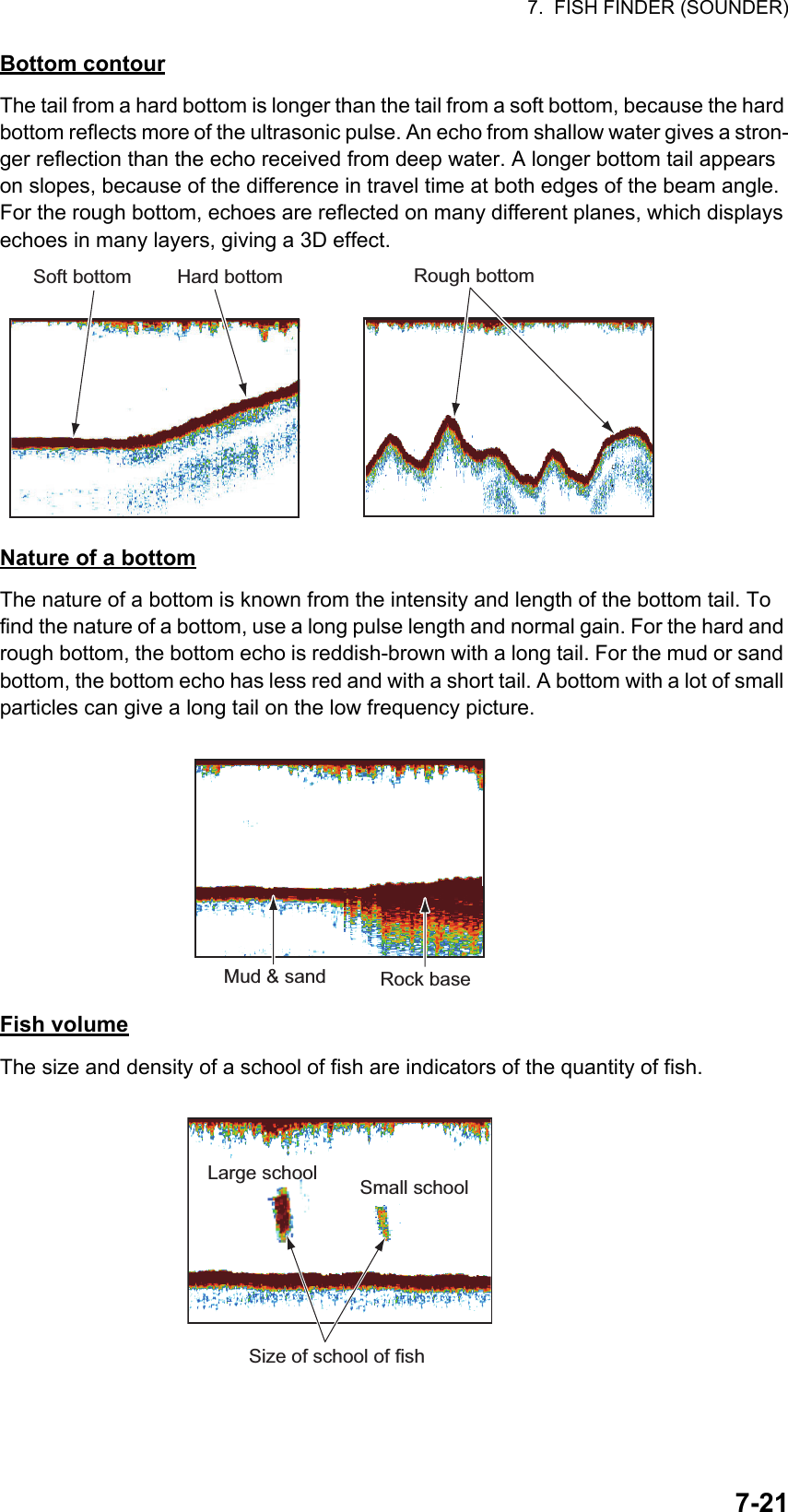
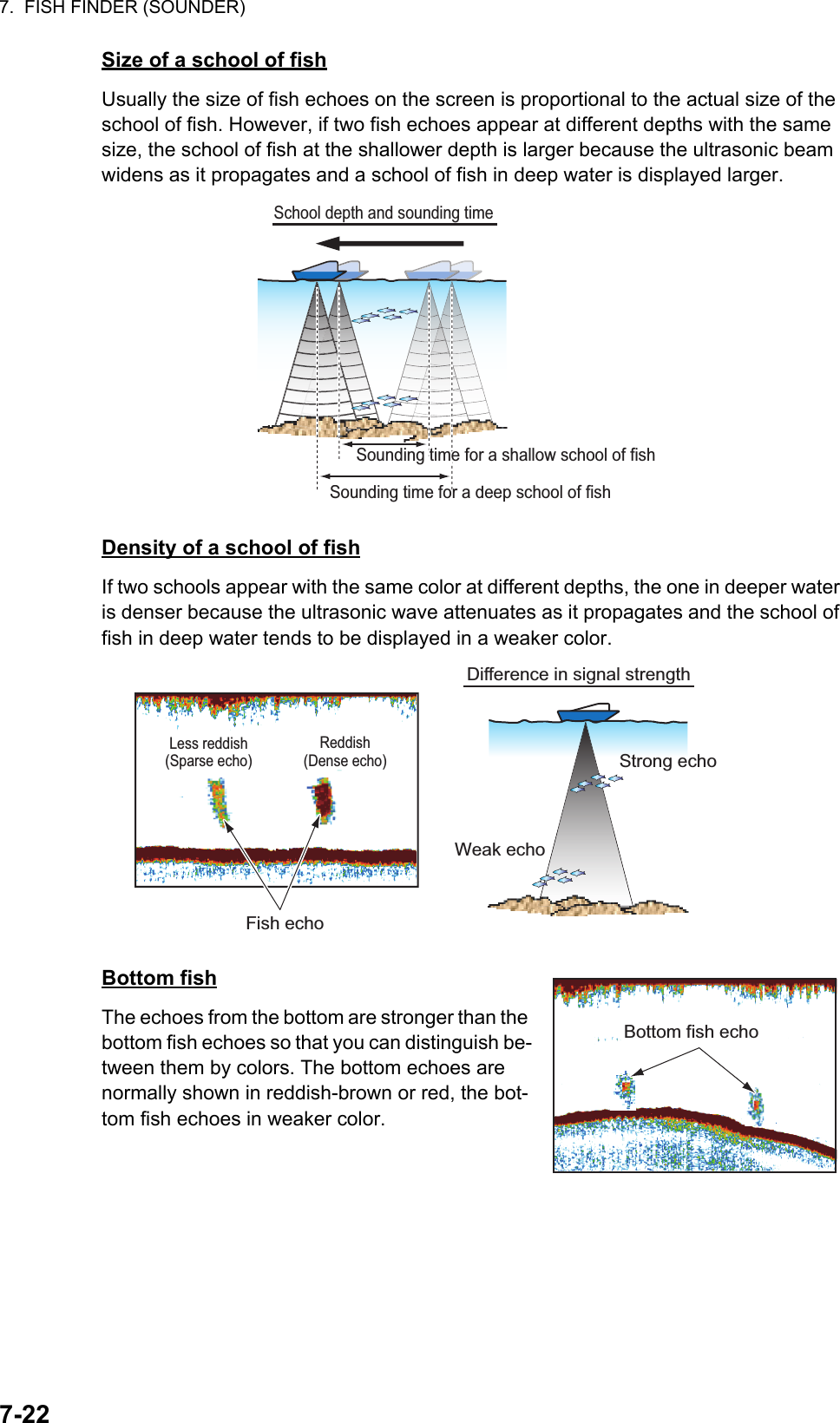
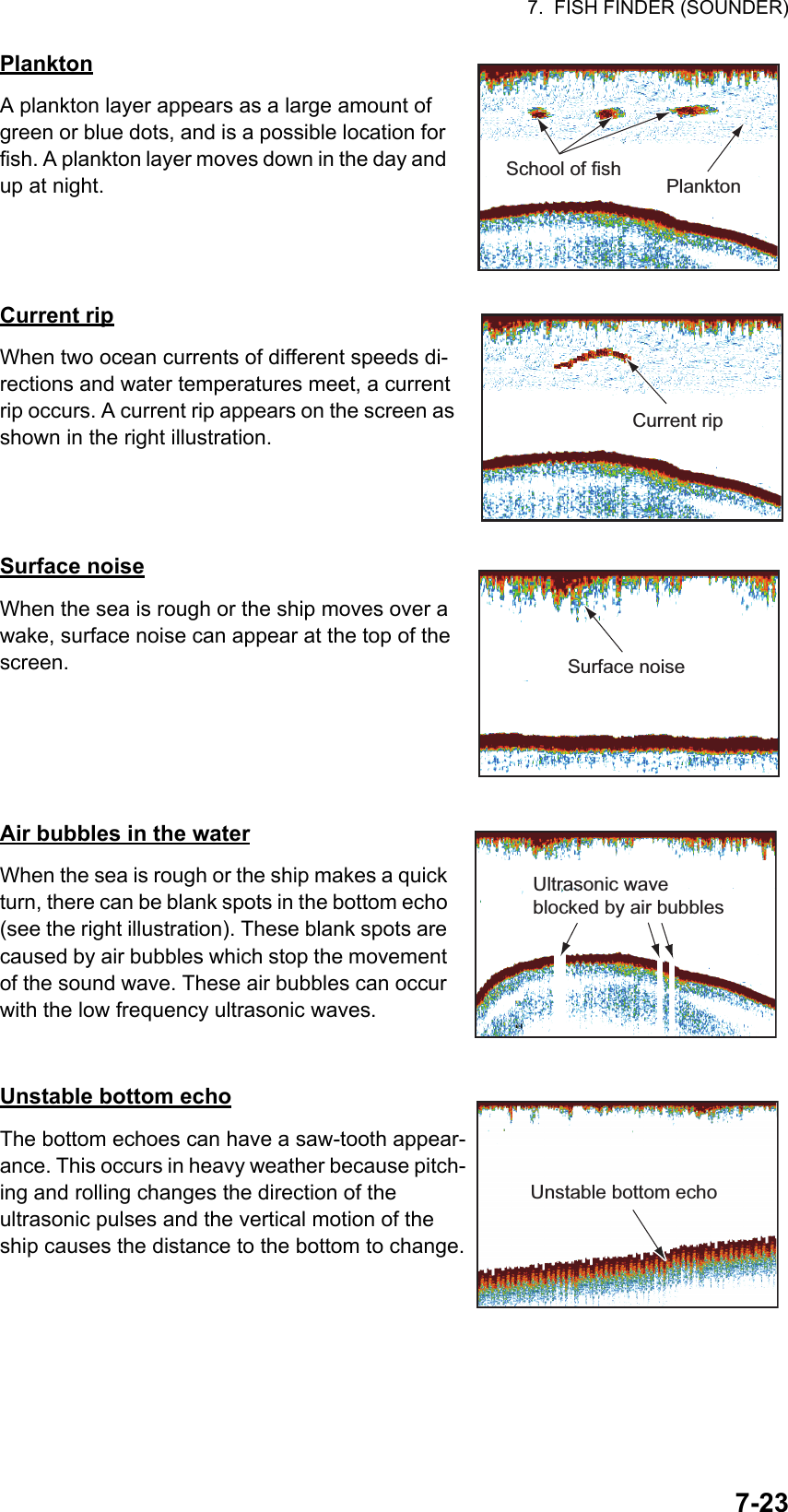
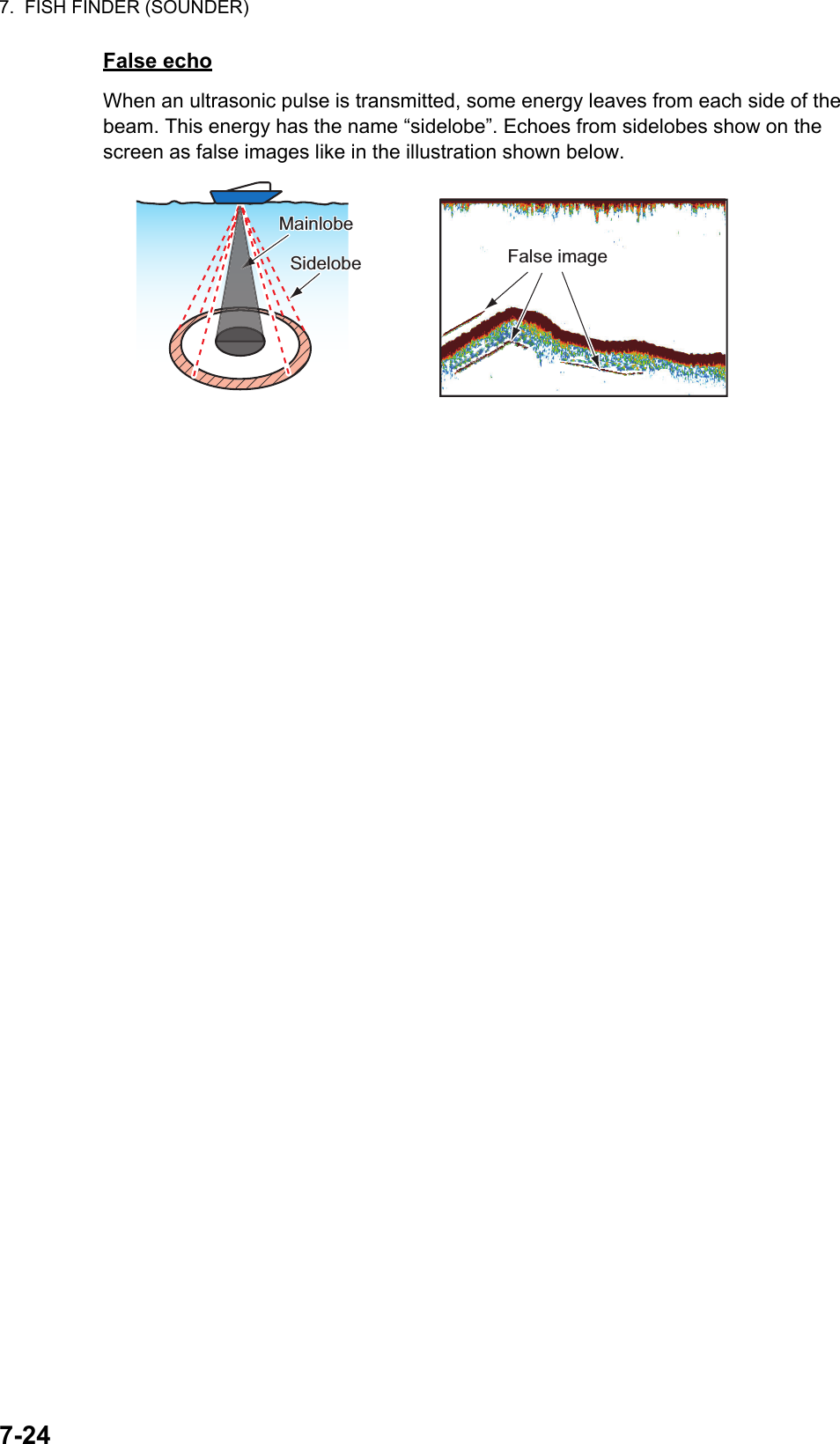
![8-18. FILE OPERATIONSPoints and routes can be imported and exported and track can be exported, using mi-cro SD cards (w/SD card unit) or USB flash drive. (The card drive at the rear of the display unit is for chart cards.)Note: DO NOT remove an SD card while it is being accessed, to prevent loss of data or damage to the card.8.1 File FormatYou can select the file format to use to export data.1. Open the home screen, then tap [Settings] - [Files].2. Tap [Export File Format].3. Tap [TZD], [CSV], [GPX] or [KML].[TZD]: For NavNet TZtouch2[CSV]*: For use with NavNet 3D[GPX]: For use with PC plotter[KML]: For use with PC plotter* The CSV format has the following export restrictions:- 2000 points maximum- 200 routes (100 points per route) maximum- 10000 track points maximum4. Tap the close button to finish.](https://usermanual.wiki/Furuno-USA/9ZWRTR104.User-Manual-II-Part-9/User-Guide-2522493-Page-10.png)
![8. FILE OPERATIONS8-28.2 How to Export Points and RoutesWhen the capacity for point is reached, the oldest point is erased to clear space for new point. A new route cannot be entered when the memory for routes is full. If you need to save points and routes permanently, save them to a micro SD card.1. Put a formatted micro SD card in the right hand card slot in the SD card unit.2. Open the home screen, then tap [Settings] - [Files].3. Tap [Export All Points & Routes].4. Tap [SDCardRight].5. You are asked if you are sure to export points and routes. Tap [OK].6. The message "EXPORT SUCCEEDED" appears if the exporting was successful. Tap [OK] to finish.8.3 How to Import Points and RoutesYou can import points and routes to the internal memory of a NavNet TZtouch2 unit.1. Put the correct micro SD card in the SD card unit.2. Open the home screen, then tap [Settings] - [Files].3. Tap [Import Points & Routes]. A list of files stored on the SD card appear.4. Tap the points and routes file to import. You are asked if you are sure to import points and routes. Tap [OK].5. The message "IMPORT SUCCEEDED" appears if the importing was successful. Tap [OK] to finish.Points and routes file](https://usermanual.wiki/Furuno-USA/9ZWRTR104.User-Manual-II-Part-9/User-Guide-2522493-Page-11.png)
![8. FILE OPERATIONS8-38.4 How to Import or Export TrackHow to import trackYou can import tracks to the internal memory of a NavNet TZtouch2 unit.1. Put the correct micro SD card in the SD card unit.2. Open the home screen, then tap [Settings] - [Files].3. Tap [Import Tracks]. A list of files stored on the SD card appears. Tap a tracks file. 4. You are asked if you are sure to import tracks. Tap [OK].5. The message "IMPORT SUCCEEDED" appears if the importing was successful. Tap [OK] to finish.How to export trackYou can export tracks to a micro SD card.1. Put a blank formatted micro SD card in the SD card unit.2. Open the home screen, then tap [Settings] - [Files].3. Tap [SDCardRightl].4. You are asked if you are sure to export tracks. Tap [OK].5. The message "EXPORT SUCCEEDED" appears if the exporting was successful. Tap [OK] to finish.8.5 How to Backup the Equipment SettingsYou can save the settings to a micro SD card to use the settings on other NavNetTZtouch2 units.1. Put a blank formatted micro SD card in the SD card unit.2. Open the home screen, then tap [Settings] - [Files].3. Tap [BackUp Settings].4. Tap [SDCardRight]The message "EXPORT SUCCEEDED" appears if the exporting was successful. Tap [OK] to finish.Tracks fileTracks file](https://usermanual.wiki/Furuno-USA/9ZWRTR104.User-Manual-II-Part-9/User-Guide-2522493-Page-12.png)
![8. FILE OPERATIONS8-48.6 How to Load the Equipment SettingsYou can load the saved settings in a micro SD card to this unit.1. Put the correct micro SD card in the SD card unit.2. Open the home screen, then tap [Settings] - [Files].3. Tap [Restore Settings].4. Tap [SDCardRight]. A list of user settings appears. Tap a user settings file.5. You are asked if you are sure to restore settings. Tap [OK].6. The message "IMPORT SUCCEEDED" appears if the importing was successful. Tap [OK] to finish.](https://usermanual.wiki/Furuno-USA/9ZWRTR104.User-Manual-II-Part-9/User-Guide-2522493-Page-13.png)
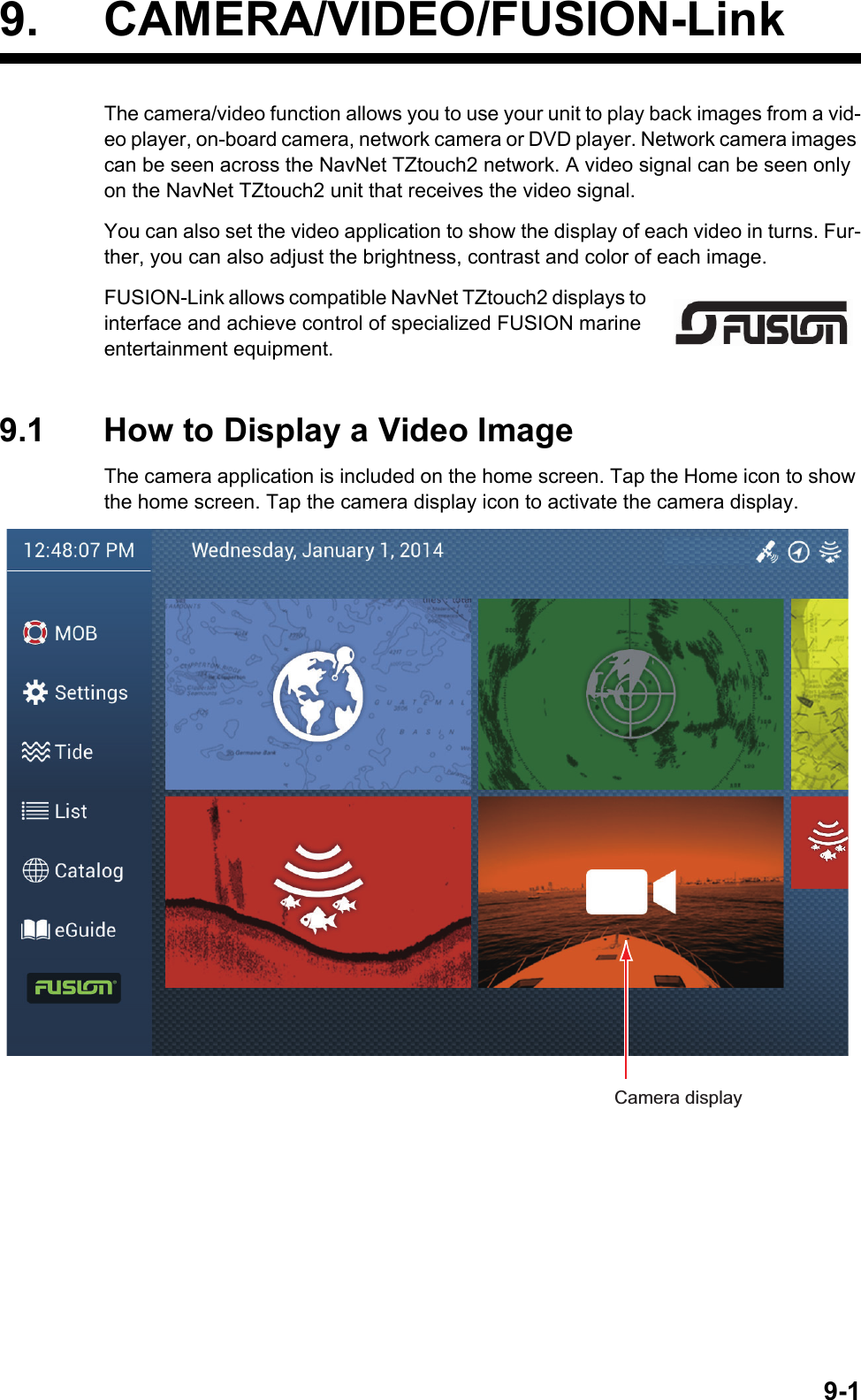
![9. CAMERA/VIDEO/FUSION-Link9-29.2 Video Signal TypeThere are three types of video signals connected to this equipment.• Analog: Images from a video player, on-board camera or DVD player• FLIR: Images from a FLIR brand infrared camera• OceanView: Images from an Oceanview brand camera9.3 How to Set the Video Display9.3.1 How to set the video signalFLIR cameraImages from an infrared camera allow you to navigate easily at night or in bad weath-er. Open the home screen, then [Settings] - [Camera] - [FLIR Installation].Note: To use the PTZ function of the FLIR camera with the NavNet TZtouch2, a set-ting (Nexus CGI Interface, port: 8090) is required at the FLIR camera. See the opera-tor’s manual of the FLIR camera for details.[Scan IP]: Tap [Scan IP] to scan the IP address automatically when connecting an FLIR camera.[FLIR IP]: Enter the IP address manually with the software keyboard then tap .[Video Source]: Select the input source for the FLIR.[Camera Offset (Right-left)]: Adjust the side position of the FLIR camera.[Camera Offset (Up-Down)]: Adjust the up-and down position of the FLIR camera.[Automatic Zoom]: Turn on to turn on the automatic zoom.[Zoom Distance]: Set the distance to zoom automatically.[Camera Altitude]: Set the altitude for the FLIR camera.](https://usermanual.wiki/Furuno-USA/9ZWRTR104.User-Manual-II-Part-9/User-Guide-2522493-Page-15.png)
![9. CAMERA/VIDEO/FUSION-Link9-3OceanView cameraImages from an OceanView camera allow you to navigate easily at night or in bad weather. Open the home screen, then tap [Settings] - [Camera] - [OceanView Instal-lation].[OceanView IP]: Enter the IP address of the OceanView camera.[Low Light Cam]: Select the low light camera (if any).[Thermal Camera]: Select the thermal camera (if any).[Camera Offset (Right-left)]: Adjust the side position of the FLIR camera.[Camera Offset (Up-Down)]: Adjust the up-and down position of the FLIR camera.[Automatic Zoom]: Turn on to turn on the automatic zoom.[Zoom Distance]: Set the distance to zoom automatically.[Camera Altitude]: Set the altitude for the FLIR camera.9.3.2 How to adjust the image sizeYou can adjust the image size from the pop-up menu.1. In the camera mode, tap the screen to show the pop-up menu.2. Tap the camera display to adjust.3. Tap [Stretch] or [Fit].[Stretch]: Shrink or enlarge the image to fit the monitor’s width.[Fit]: Shrink or enlarge the image to fit the monitor’s height. The as-pect ratio is kept, so a black bar appears on the right and left sides of the picture, but this is normal.4. Adjust the top slider for width; bottom slider for height.5. Tap the close button to finish.Stretch, fit](https://usermanual.wiki/Furuno-USA/9ZWRTR104.User-Manual-II-Part-9/User-Guide-2522493-Page-16.png)
![9. CAMERA/VIDEO/FUSION-Link9-49.3.3 How to switch your video inputsIf you have more than one camera installed, you can switch your video inputs from the camera screen.1. On a camera display, tap the screen to show the pop-up menu.2. Tap the camera image to show, at the top of the window.9.3.4 How to adjust the video imageTap the screen to show the pop-up menu. Tap [Contrast] or [Brilliance], then drag the slider to adjust.Input sourcesDrag slider to set.Current settingTap screen to show pop-up menu. Tap [Contrast] or [Brilliance].](https://usermanual.wiki/Furuno-USA/9ZWRTR104.User-Manual-II-Part-9/User-Guide-2522493-Page-17.png)
![9. CAMERA/VIDEO/FUSION-Link9-59.4 Control of FLIR Camera[Camera FoV] menuYou can display the field of view by the FLIR camera on the plotter display.1. Tap the boat icon to display the pop-up menu.2. Tap [Cone]. The boat icon is put inside a red translucent circle.[Move Camera] and [Lock Camera] menusYou can rotate the FLIR camera about the position you select (touch) on the plotter or radar display. Open the pop-up menu then tap [Lock Camera]. To track the position, tap [Move Camera] on the pop-up menu.9.5 Tracking Active Waypoint, MOBThe camera can be set to automatically track the active waypoint and/or MOB. Open the [Settings] - [Camera] menu and then turn on [Automatic Lock on Active Waypoint] or [Automatic Lock on MOB] as required.9.6 Touch Control on the Camera DisplayOperation FunctionTap Opens the pop-up menu. During zoom mode, center the position tapped.](https://usermanual.wiki/Furuno-USA/9ZWRTR104.User-Manual-II-Part-9/User-Guide-2522493-Page-18.png)
![9. CAMERA/VIDEO/FUSION-Link9-69.7 FUSION-LinkFUSION-Link allows compatible NavNet TZtouch2 displays to interface and achieve control of specialized FUSION marine entertainment equipment.9.7.1 How to access the FUSION screen and controlsThe FUSION controls can be accessed in three methods:• FUSION on the home screen• Slide-out menu (minimized screen appears), and• Function GestureMethod 1: FUSION icon (for full window)Tap [FUSION] om the home screen.Example1: iPod in the full screenDragslider to adjust volume.Show or hide [ZONES] panel.Show or hide[MENU] panel.Tap: Goto previous title.Hold down: Go back.ClosebuttonTap: Goto next number.Hold down: Fast forward.Swipe to change source.Show or hide [TONES] panel(tone controls).PlaybackLower volume.Raise volume.Mute/unmute.Select track/album.Repeat on/off.Globallyadjustvolume.Zones 1 and 2 volumes synched.Zones 1 and 2 volumes independent.](https://usermanual.wiki/Furuno-USA/9ZWRTR104.User-Manual-II-Part-9/User-Guide-2522493-Page-19.png)